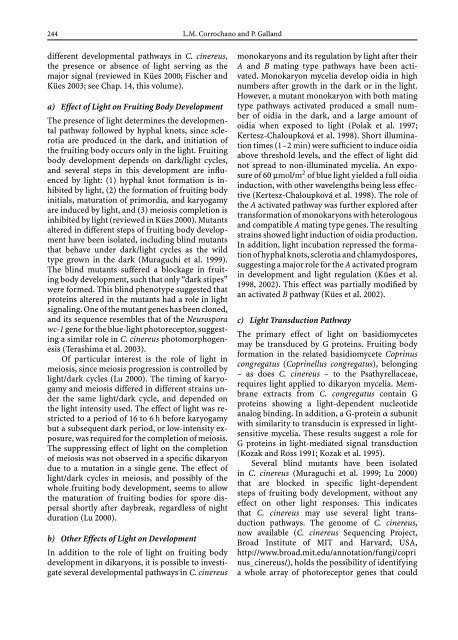Growth, Differentiation and Sexuality
Growth, Differentiation and Sexuality
Growth, Differentiation and Sexuality
Create successful ePaper yourself
Turn your PDF publications into a flip-book with our unique Google optimized e-Paper software.
244 L.M. Corrochano <strong>and</strong> P. Gall<strong>and</strong><br />
different developmental pathways in C. cinereus,<br />
the presence or absence of light serving as the<br />
major signal (reviewed in Kües 2000; Fischer <strong>and</strong><br />
Kües 2003; see Chap. 14, this volume).<br />
a) Effect of Light on Fruiting Body Development<br />
The presence of light determines the developmental<br />
pathway followed by hyphal knots, since sclerotia<br />
are produced in the dark, <strong>and</strong> initiation of<br />
the fruiting body occurs only in the light. Fruiting<br />
body development depends on dark/light cycles,<br />
<strong>and</strong> several steps in this development are influenced<br />
by light: (1) hyphal knot formation is inhibited<br />
by light, (2) the formation of fruiting body<br />
initials, maturation of primordia, <strong>and</strong> karyogamy<br />
are induced by light, <strong>and</strong> (3) meiosis completion is<br />
inhibited by light (reviewed in Kües 2000). Mutants<br />
altered in different steps of fruiting body development<br />
have been isolated, including blind mutants<br />
that behave under dark/light cycles as the wild<br />
type grown in the dark (Muraguchi et al. 1999).<br />
The blind mutants suffered a blockage in fruiting<br />
body development, such that only “dark stipes”<br />
were formed. This blind phenotype suggested that<br />
proteinsalteredinthemutantshadaroleinlight<br />
signaling. One of the mutant genes has been cloned,<br />
<strong>and</strong> its sequence resembles that of the Neurospora<br />
wc-1 gene for the blue-light photoreceptor, suggesting<br />
a similar role in C. cinereus photomorphogenesis<br />
(Terashima et al. 2003).<br />
Of particular interest is the role of light in<br />
meiosis, since meiosis progression is controlled by<br />
light/dark cycles (Lu 2000). The timing of karyogamy<br />
<strong>and</strong> meiosis differed in different strains under<br />
the same light/dark cycle, <strong>and</strong> depended on<br />
thelightintensityused.Theeffectoflightwasrestrictedtoaperiodof16to6h<br />
before karyogamy<br />
but a subsequent dark period, or low-intensity exposure,<br />
was required for the completion of meiosis.<br />
The suppressing effect of light on the completion<br />
of meiosis was not observed in a specific dikaryon<br />
due to a mutation in a single gene. The effect of<br />
light/dark cycles in meiosis, <strong>and</strong> possibly of the<br />
whole fruiting body development, seems to allow<br />
the maturation of fruiting bodies for spore dispersal<br />
shortly after daybreak, regardless of night<br />
duration (Lu 2000).<br />
b) Other Effects of Light on Development<br />
Inadditiontotheroleoflightonfruitingbody<br />
development in dikaryons, it is possible to investigate<br />
several developmental pathways in C. cinereus<br />
monokaryons <strong>and</strong> its regulation by light after their<br />
A <strong>and</strong> B mating type pathways have been activated.<br />
Monokaryon mycelia develop oidia in high<br />
numbers after growth in the dark or in the light.<br />
However, a mutant monokaryon with both mating<br />
type pathways activated produced a small number<br />
of oidia in the dark, <strong>and</strong> a large amount of<br />
oidia when exposed to light (Polak et al. 1997;<br />
Kertesz-Chaloupková et al. 1998). Short illumination<br />
times (1–2 min) were sufficient to induce oidia<br />
above threshold levels, <strong>and</strong> the effect of light did<br />
not spread to non-illuminated mycelia. An exposure<br />
of 60 μmol/m 2 of blue light yielded a full oidia<br />
induction, with other wavelengths being less effective<br />
(Kertesz-Chaloupková et al. 1998). The role of<br />
the A activated pathway was further explored after<br />
transformation of monokaryons with heterologous<br />
<strong>and</strong> compatible A mating type genes. The resulting<br />
strains showed light induction of oidia production.<br />
In addition, light incubation repressed the formation<br />
of hyphal knots, sclerotia <strong>and</strong> chlamydospores,<br />
suggesting a major role for the A activated program<br />
in development <strong>and</strong> light regulation (Kües et al.<br />
1998, 2002). This effect was partially modified by<br />
an activated B pathway (Kües et al. 2002).<br />
c) Light Transduction Pathway<br />
The primary effect of light on basidiomycetes<br />
may be transduced by G proteins. Fruiting body<br />
formation in the related basidiomycete Coprinus<br />
congregatus (Coprinellus congregatus), belonging<br />
–asdoesC. cinereus – to the Psathyrellaceae,<br />
requires light applied to dikaryon mycelia. Membrane<br />
extracts from C. congregatus contain G<br />
proteins showing a light-dependent nucleotide<br />
analog binding. In addition, a G-protein α subunit<br />
with similarity to transducin is expressed in lightsensitive<br />
mycelia. These results suggest a role for<br />
G proteins in light-mediated signal transduction<br />
(Kozak <strong>and</strong> Ross 1991; Kozak et al. 1995).<br />
Several blind mutants have been isolated<br />
in C. cinereus (Muraguchi et al. 1999; Lu 2000)<br />
that are blocked in specific light-dependent<br />
stepsoffruitingbodydevelopment,withoutany<br />
effect on other light responses. This indicates<br />
that C. cinereus may use several light transduction<br />
pathways. The genome of C. cinereus,<br />
now available (C. cinereus Sequencing Project,<br />
Broad Institute of MIT <strong>and</strong> Harvard, USA,<br />
http://www.broad.mit.edu/annotation/fungi/copri<br />
nus_cinereus/), holds the possibility of identifying<br />
a whole array of photoreceptor genes that could

















